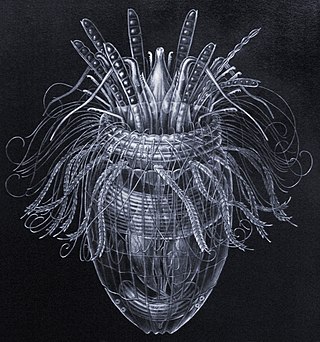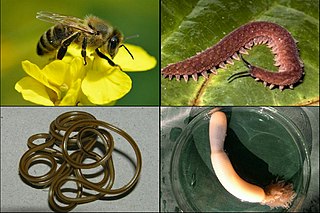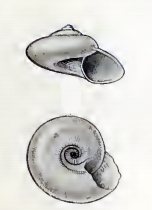The Ordovician is a geologic period and system, the second of six periods of the Paleozoic Era. The Ordovician spans 41.6 million years from the end of the Cambrian Period 485.4 million years ago (Mya) to the start of the Silurian Period 443.8 Mya.
The Permian is a geologic period and stratigraphic system which spans 47 million years from the end of the Carboniferous Period 298.9 million years ago (Mya), to the beginning of the Triassic Period 251.9 Mya. It is the last period of the Paleozoic Era; the following Triassic Period belongs to the Mesozoic Era. The concept of the Permian was introduced in 1841 by geologist Sir Roderick Murchison, who named it after the region of Perm in Russia.

Loricifera is a phylum of very small to microscopic marine cycloneuralian sediment-dwelling animals with 43 described species. and approximately 100 more that have been collected and not yet described. Their sizes range from 100 μm to ca. 1 mm.

Machaeridia is an extinct group of armoured, segmented annelid worms, known from the Early Ordovician to Carboniferous. It consists of three distinct families: the plumulitids, turrilepadids and lepidocoleids.

Ecdysozoa is a group of protostome animals, including Arthropoda, Nematoda, and several smaller phyla. The grouping of these animal phyla into a single clade was first proposed by Eernisse et al. (1992) based on a phylogenetic analysis of 141 morphological characters of ultrastructural and embryological phenotypes. This clade, that is, a group consisting of a common ancestor and all its descendants, was formally named by Aguinaldo et al. in 1997, based mainly on phylogenetic trees constructed using 18S ribosomal RNA genes.

Caenogastropoda is a taxonomic subclass of molluscs in the class Gastropoda. It is a large diverse group which are mostly sea snails and other marine gastropod mollusks, but also includes some freshwater snails and some land snails. The subclass is the most diverse and ecologically successful of the gastropods.

Pareiasaurs are an extinct clade of large, herbivorous parareptiles. Members of the group were armoured with osteoderms which covered large areas of the body. They first appeared in southern Pangea during the Middle Permian, before becoming globally distributed during the Late Permian. Pareiasaurs were the largest reptiles of the Permian, reaching sizes equivalent to those of contemporary therapsids. Pareiasaurs became extinct at the end of the Permian during the Permian-Triassic extinction event.

Cluster flies are flies of the genus Pollenia in the family Polleniidae. Unlike the more familiar blow flies, such as the bluebottle genus Phormia, they are completely harmless to human health because they do not lay eggs in human food. They are parasitic on earthworms; the females lay their eggs near earthworm burrows, and the larvae then feed on the worms. But the biology of this group is relatively poorly known and a few have been recorded from other hosts including caterpillars and bees.

Hybodus is an extinct genus of hybodont, a group of shark-like elasmobranchs that lived from the Late Devonian to the end of the Cretaceous. Species closely related to the type species Hybodus reticulatus lived during the Early Jurassic epoch. Numerous species have been assigned to Hybodus spanning a large period of time, and it is currently considered a wastebasket taxon that is 'broadly polyphyletic' and requires reexamination. The first fossilized teeth from Hybodus were found in England around 1845; since then teeth have been recovered from Europe. During the Triassic, Jurassic, and Cretaceous periods, the hybodonts were especially successful and could be found in shallow seas around the world. For reasons that are not fully understood, the hybodonts became extinct near the end of the Late Cretaceous period.

Neritidae, common name the nerites, is a taxonomic family of small to medium-sized saltwater and freshwater snails which have a gill and a distinctive operculum.

Turritellidae, with the common name "tower shells" or "tower snails", is a taxonomic family of small- to medium-sized sea snails, marine gastropod molluscs in the Sorbeoconcha clade.

Solariellidae is a family of small sea snails, marine gastropod mollusks in the superfamily Trochoidea.
Plumulites is an extinct genus of machaeridians, extinct annelid group.

Julian Pender Hume is an English palaeontologist, artist and writer who lives in Wickham, Hampshire. He was born in Ashford, Kent, and grew up in Portsmouth, England. He attended Crookhorn Comprehensive School between 1971 and 1976. His career began as an artist, specialising in the reconstruction of extinct species, after which he undertook a degree in palaeontology at the University of Portsmouth, followed by a PhD in the same subject, jointly hosted by the University of Portsmouth and the Natural History Museum, London and Tring. He is presently a research associate at the Natural History Museum, and has travelled extensively, working on fossil excavations that include the Cape Verde Islands; Lord Howe Island, Tasmania, Flinders, King and Kangaroo Islands, Australia; Madagascar, Seychelles, and Hawaiian Islands. However, his main area of research is the Mascarene Islands of Mauritius, Réunion, and Rodrigues, where in particular he has studied the history of the dodo.
Chris Brooks is Professor of Finance in the School of Accounting and Finance at the University of Bristol, United Kingdom.

Prolimnocyon is an extinct paraphyletic genus of limnocyonid hyaenodonts that lived in Asia and North America during the late Paleocene to middle Eocene. Prolimnocyon chowi is the earliest known member of the hyaenodontid family Limnocyonidae.
3. Gügel, De Baets, K., Jerjen, I., Schuetz, P., & Klug, C. (2017). A new subdisarticulated machaeridian from the Middle Devonian of China: Insights into taphonomy and taxonomy using X-ray microtomography and 3D-analysis. Acta Palaeontologica Polonica, 62(2), 237–247. https://doi.org/10.4202/app.00346.2017
4. Pereira, Colmenar, J., Mortier, J., Vanmeirhaeghe, J., Verniers, J., Štorch, P., Taylor Harper, D. A., & Gutiérrez-Marco, J. C. (2021). Hirnantia Fauna from the Condroz Inlier, Belgium: another case of a relict Ordovician shelly fauna in the Silurian? Journal of Paleontology, 95(6), 1189–1215. https://doi.org/10.1017/ jpa.2021.74
5. Vinther, & Briggs, D. E. . (2009). Machaeridian locomotion. Lethaia, 42(3), 357–364. https://doi.org/10.1111/j.1502-3931.2009.00165.x











